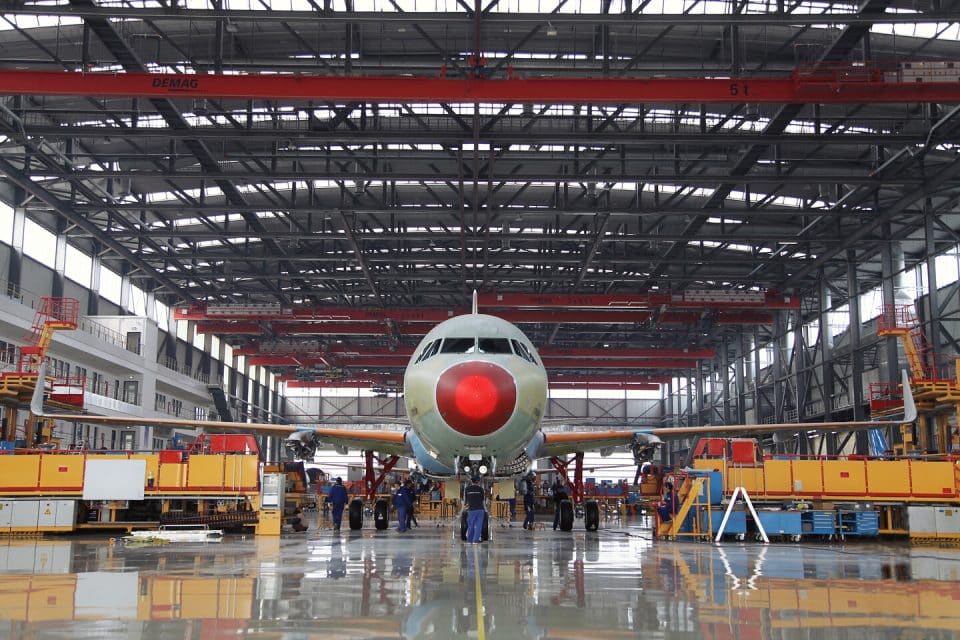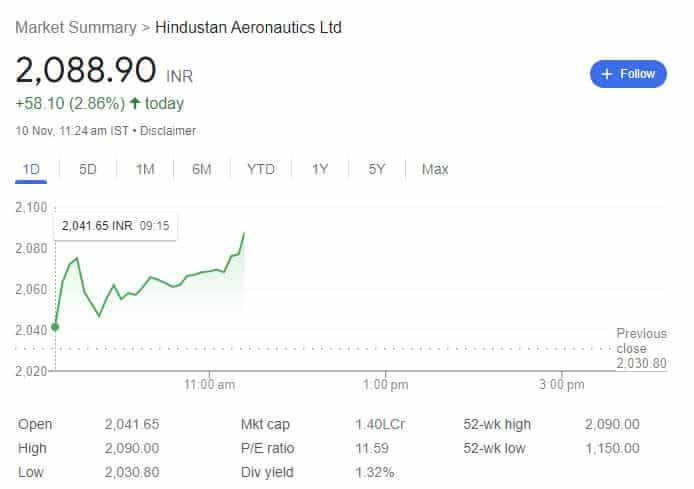Aerospace
HAL’s Share Price Surges 10% in November 2023 on Airbus MRO Contracts and Self-Reliance Goals

In the Indian market, HAL (Hindustan Aeronautics Limited) is currently making headlines for receiving a significant boost in business from Airbus. The Hindustan Aeronautics Limited shares price increased by almost 10% in November 2023. as it received business orders from Airbus.
HAL share price today
Airbus has signed new contracts with numerous Indian suppliers to produce commercial aircraft parts, assisting the Indian government in realizing its “AatmaNirbharBharat” objective.
HAL share price nse is currently at hal share price today Rs 2055. It increased the 1.05% shares yesterday. According to the record, its price on November 1st was about Rs 1822. Other companies associated with Aerospace Deals have also seen a sharp rise in prices.

Airbus wing parts for the A320neo, A330neo, and A350
Contracts for the supply of airframe and Wing parts for the A320neo, A330neo, and A350 programs have been signed by Airbus with Aequs, Dynamatic, Gardner, and Mahindra Aerospace.
The latest agreements will help Airbus accelerate its commercial aircraft programs worldwide and enhance the nation’s aviation ecosystem’s knowledge and capabilities in various areas, including sheet metal, machining, and extrusion profiles.
Keypoints.
- HAL and Airbus Collaboration:
- Hindustan Aeronautics Ltd (HAL) is partnering with Airbus to establish a Maintenance Repair Overhaul (MRO) facility for the Airbus A320 family aircraft.
- Airbus is collaborating with HAL to support HAL’s entry into commercial aircraft servicing.
- Government’s Push for Localization:
- The Modi government is encouraging aircraft manufacturers like Airbus and Boeing to source components from India, set up MRO facilities, and eventually establish a final assembly line in the country.
- Orders worth $120 billion have been placed by Air India and IndiGo for nearly 1,000 Airbus A320 family aircraft.
- Impact on Airlines:
- Private airlines, including Air India, cannot offset requirements when placing aircraft orders.
- The government aims to benefit from these orders through increased supply chains and the establishment of MRO facilities within India.
- Airbus’s Commitment:
- Airbus is committed to the holistic development of India’s aviation ecosystem and supports the growth of an indigenous MRO industry.
- Airbus will assist HAL in tapping into the growing demand for MRO services, especially for the A320 family of aircraft.
- Aircraft Types and Customers:
- The Airbus A320 is the most used narrow-body aircraft with Indian carriers.
- IndiGo is the world’s largest customer for the A320, with a substantial number of orders.
- Air India and Vistara are other major customers.
- HAL’s Vision:
- HAL has a vision to establish an integrated MRO hub in India to provide effective MRO solutions.
- This aligns with the government’s Make in India mission and the civil-military convergence.
- Airbus’s Support:
- Airbus will provide the A320 family tool package and specialized consulting services to HAL for setting up the MRO facility.
- HAL will have access to AirbusWorld, a digital platform offering support, technical data, and training solutions.
- HAL’s Capabilities:
- HAL’s Nashik division already has capabilities in civil MRO, with DGCA-approved hangars and skilled manpower from their defense activities.
These key elements help summarize the collaboration between HAL and Airbus, the government’s localization efforts, the impact on airlines, Airbus’s commitment to India’s aviation ecosystem, and HAL’s existing capabilities.

Aerospace
Boeing Transfers Rocket Stage to NASA, Paving Way for Human Moon Mission

Boeing has achieved a significant milestone by providing NASA with the second core stage of the Space Launch System (SLS) rocket.
This crucial component, crafted at NASA’s Michoud Assembly Facility (MAF), is set to propel the Artemis II crew into lunar orbit, marking humanity’s return to deep space after a 50-year hiatus.
The monumental Boeing-built rocket stage, the largest element of the Artemis II mission, will embark on a journey aboard the Pegasus barge, traveling 900 miles to NASA’s Kennedy Space Center.
Comparison of two legendary aircraft B777x vs B747 aircraft:Click here
Upon arrival, it will be meticulously integrated with other essential Artemis II components, including the upper stage, solid rocket boosters, and NASA’s Orion spacecraft within the iconic Vehicle Assembly Building. This intricate integration process is a vital step toward the eagerly anticipated Artemis II launch, slated for 2025.
“Boeing-built products helped land humankind on the moon in 1969, and we’re proud to continue that legacy through the Artemis generation,” remarked Dave Dutcher, vice president and program manager for Boeing’s SLS program. “Together, with NASA and our industry partners and suppliers, we are building the world’s most capable rocket and paving the way to deep space through America’s rocket factory in New Orleans.”
NASA, Lockheed Martin Reveal X-59 Quiet Supersonic Aircraft:Click here
The delivery of Core Stage 2 marks a significant achievement in the evolution of the SLS rocket. Towering over 200 feet and powered by four RS-25 engines, this core stage, coupled with two solid-fueled booster rockets, will generate a staggering 8.8 million pounds of thrust. This immense power is crucial to launching Artemis II and future missions into the vast expanse of space.
The SLS rocket stands unparalleled in its capability to transport both crew and substantial cargo to the moon and beyond in a single launch. Its extraordinary capacity will facilitate the delivery of human-rated spacecraft, habitats, and scientific missions to destinations including the moon and Mars, ushering in a new era of space exploration.
-

 Travel1 week ago
Travel1 week agoAir India to Expand US Operations with Three New Routes After a Decade
-

 Travel2 weeks ago
Travel2 weeks agoWhy We Should Avoid These Stamps in a Passport
-

 Airlines1 month ago
Airlines1 month agoInvestigations Reveal Fake Chinese Titanium in Boeing and Airbus Jets
-

 Tech4 weeks ago
Tech4 weeks agoChina’s CATL Plans 1,800-Mile Electric Plane Launch by 2027
-

 Airport3 days ago
Airport3 days agoTop 10 Largest Airports in the World by Size
-

 Aerospace4 weeks ago
Aerospace4 weeks agoChina’s Fighter Jets Turn Wings into Autonomous Drones
-

 Airlines4 days ago
Airlines4 days agoAir India Rolls Out A350s for Delhi-New York JFK and Newark Routes
-

 Defence3 weeks ago
Defence3 weeks agoBoeing Enhances Chinook with New Engines and Block II Upgrades at $96 Million







